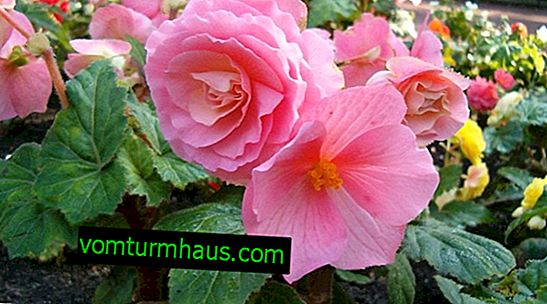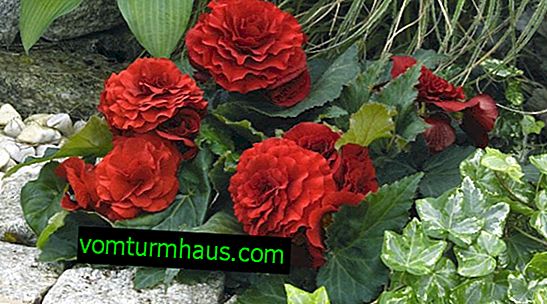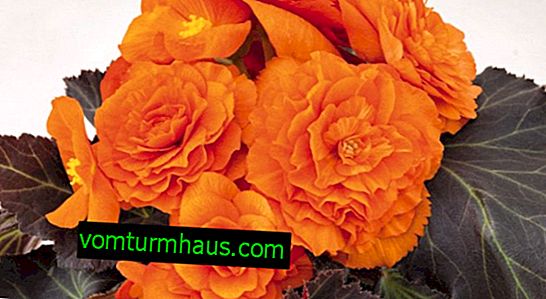Tuberous begonias: planting and care at home, breeding methods
Tuber begonia is a beautiful flower that, with proper care, will decorate not only any windowsill and loggia, but also a garden plot, because you can grow it from a tuber both in a pot and in open ground. The main thing is to properly plant the plant and take care of it in different seasons. How to do this will be described in the article.
Plant description
Tuberous begonia (Latin: Begonia x tuberhybrida) is a flowering herbaceous plant with a thick rhizome in the form of a tuber. Description of its parts is collected in the table:
| Root system | Tuberous, with a diameter up to 6 cm |
| Stem | Fleshy juicy, 20–80 cm high |
| Leaf shape | Heart-shaped, with a pointed apex |
| Leaf color | Bright and dark green |
| Flower shape | Various: camellia-like or peonies, corrugated, crispa, indented, with fringe |
| Flower diameter | 5–20 cm |
| Flower color | White, pink, orange, dark red |
| Propagation by division of tubers, seeds, cuttings | Optimum temperature +20 ... + 23 ° С |
| Origin South America | Tuber classification |
| Life expectancy 4-6 years |
Did you know? Several species of begonias were first found by a botanist from France, Charles Plumier, during an expedition to the Antilles. He named the flower after his friend Michel Begon. The first type of tuber begonia was discovered in 1864 in the highlands of South America.
Today, there are about 900 varieties of tuberous begonia. All of them have common features - the contours of the leaves are similar to the shape of a heart. The most popular large-flowered varieties:
- Yellow - with yellow inflorescences;

- Rose - with pink double flowers;

- Dark Red - with dark red terry flowers;

- Golden Orange - with orange double flowers.

Among varieties with medium-sized inflorescences, flower growers prefer Fringed Double Mixed, with small flowers - Scharlach, Gelb, Weifi. Begonia has a number of important advantages:
- long and plentiful flowering;
- wide gamut of flower stains;
- unpretentiousness in leaving;
- shade tolerance.
Basic rules for planting tubers
In order for begonia to successfully take root and already soon given abundant flowering, it is necessary to plant it correctly. To do this, you should adhere to such recommendations for landing at home:
- The size of the tuber should be at least 3 cm in diameter.
- A large tuber must be divided into several parts with a sharp knife.
- The rhizome should not be dry or sluggish, with damage, spots, rot.
- Before planting, the tuber must be treated with any fungicide or soaked for half an hour in a weak solution of potassium permanganate.
- Tuber planting should be carried out on a rounded side with growth points down into moist peat. You need to deepen it to half. The upper part should rise above the ground.
- The first watering should be sparse and rare. The frequency and intensity of the liquid feed should be increased gradually.
- During the growth of the sprouts, the container with tubers should be in a bright place, but it must be protected from direct sunlight. In the future, it is not recommended to change the illumination - this may not have the best effect on the growth and development of the plant.
- The temperature at the germination stage should be +15 ... + 17 ° C.
- A transplant to a permanent place - in a pot or in open ground - is done when the sprouts reach a height of 5 cm.
Important! For a tuberous begonia, proper planting is much more important than subsequent care. Therefore, it is necessary to plant a plant by carefully studying the recommendations for deepening tubers into the soil and caring for seedlings.
Optimal landing conditions
Begonia can be planted in two ways: seedlings and seedlings. In the first case, the tubers are placed in peat so that they sprout. In the future, when they form real leaves, they will need to be transplanted to a permanent place. In the seedless method, tubers are immediately placed in a permanent pot or soil.

In a pot
Before planting, you need to choose a pot. Preference should be given to medium-sized, shallow and not too wide containers, with an approximate diameter of 12 cm. When planting from the top of the tuber to the edge of the pot, 3-4 cm should remain. These flowers are planted in pots in February - March. Soil for planting will require moist, loose, well-permeable moisture and air. It should have a lot of nutrients and sand.
Learn how to plant indoor flowers in a pot.
You can compose it as follows:
- deciduous soil - 3 parts;
- peat - 1 part;
- sand - 1 part.

A step-by-step instruction for planting begonias in a pot is as follows:
- At the bottom of the pot lay a layer of expanded clay or other material that will play the role of drainage.
- Pour the prepared substrate into the container.
- Make a recess in the center.
- Place the tuber in the recess.
- Sprinkle the rhizome, leaving the kidneys open.
- Water abundantly.
- After the sprouts reach a height of 4-5 cm, add soil, covering almost completely the tuber.
The plant loves diffused sunlight (but can grow well in partial shade), high humidity - at the level of 60–70% and warm temperatures - +20 ... + 23 ° C. The smaller the flowers, the more light they require. During the winter months, begonia falls into a state of rest. At this time, it must be transferred to a dark, cool room with a temperature of about +12 ° C.
Did you know? The people believe that begonia absorbs the negative energy that accumulates in the house. Instead, it brings harmony and tranquility. A plant with red flowers is advised to be placed in the bedroom, and with white and pink in the kitchen, loggia, hallway.
At this time, the flower does not stop moisturizing. After exiting the dormant period, the plant needs to be transplanted into a larger pot - 20 cm in diameter. It is not worth changing the lighting for the flower during growth, this can negatively affect its condition.
Video: how to plant tuberous begonia
In open ground
For planting in the garden, it is better to prepare seedlings. Tubers planted in peat in March. Starting from the end of April - from the first week of May, plants will need to be tempered - for several minutes, and gradually increasing the time, take the pots out. Hardened plants adapt faster in a new place and will be less susceptible to diseases and parasites. Begonia should be planted on an open area at a time when there is no longer a threat of frost - in May - June. It is better to choose a place that warms up in the morning sun. It can be planted under trees or in the shade of higher plants.
Check out ornamental plants like coral begonia and mason begonia.
The site should be protected from drafts. If frost does occur, the bush must be insulated by shelter. As in the case of planting in a pot, sprouts or tubers need to be planted in loose nutrient soil. Heterose varieties are familiar to denser soil. The distance between plants should be 30–35 cm. The permissible deepening of sprouts grown from tubers is 2–2.5 cm lower than they grew in a pot, from purchased seeds –– 1–1.5 cm lower. Before planting, potassium and phosphorus-containing fertilizers are added to the well.

Growing and caring at home
In general, begonia does not require special care measures. We need regular watering, top dressing, pruning and replanting.
Watering
It is advisable to water the plants in pots in the morning once every 3 days, so that before the rays of the sun the organs of the flower can dry out and not get burns. Water should be settled and room temperature. Bays should be avoided. Often, in order to maintain the necessary level of humidity, begonia breeders place pots with it in trays with wet peat. Twice or thrice a week, you will need help from the sprayer. In the summer, more frequent watering and spraying are needed, twice a day - in the morning and in the evening.

Top dressing
After planting at intervals of a week, do 2-3 dressings with potassium nitrate. Later, every 2 weeks, universal fertilizer with a small amount of nitrogen will be required.
Important! Excess nitrogen threatens to stretch the stems and rot the plant.
The last top dressing must be done in early October. Thus, the plant will have time to prepare for the transition to a dormant period.
How to trim and transplant
Begonia is pruned to form a bush before wintering. In young plants, in which the stem has grown to a height of 6-7 cm, you need to cut off the top. This will give a start to the development of side shoots. Side shoots are pruned when they grow 10 cm.

- An earthen lump is removed from the old tank, the tuber is cleaned of it, examined for damage.
- Then placed in a new pot and covered with prepared substrate, which is purchased in a specialized store or prepared independently from half of deciduous land and half of sand, peat and manure.
Young plants are transplanted annually. More mature - 1 time in 2 years.
Read more about how to properly transplant a monstera at home.
Propagation Features
Begonia can be propagated in 4 ways:
- using cuttings;
- seeds;
- tuber division;
- fragment of the leaf.
Video: Tuberous begonia breeding
Cuttings
For cuttings in April - May, shoots are cut with 2 or more buds and several leaves 10 cm long and placed in a sand-peat mixture. The substrate is periodically watered. It is important to ensure that it is not waterlogged. The container is covered with a glass cap or a plastic bottle and periodically ventilated. 2–4 weeks after root formation, the stalk is planted in a pot.
Find out how to use iodine to fertilize geranium.
From seed
Begonia is rarely propagated by seeds, since it is very troublesome. Basically, this method is used by specialists who need to maintain varietal qualities. At home, this method is usually not used. The fact is that begonias have too small seeds. In addition, the seed must be specially treated before planting. Later it is treated with growth stimulants and planted in open ground under a film or in a container with a mixture of foliage, turf, peat and sand under a glass, maintaining a temperature of +22 ... + 25 ° С.

Division of a bush or rhizomes
Most often, at home, begonia is propagated by dividing tubers. This is done as follows:
- One tuber is divided with a knife into several lobes, leaving 2-3 growth points on each.
- Places of cuts are treated with charcoal.
- Shares are planted in peat for growing seedlings or immediately into the soil.
- They are watered periodically.
- After the appearance of strong sprouts, they are transferred to a permanent place of residence.

Leaves
Reproduction by leaves is produced in those varieties that have a fluff on the underside of the leaf or with a creeping stem. Instruction:
- A strong fleshy leaf is cut from the stem, cut into several triangular parts, leaving at least one vein in each fragment.
- These fragments are planted with a slice down in containers filled with substrate or sand.
- Cover with glass or a plastic bottle and periodically ventilate and spray.
- After 20 days, young leaflets should appear. Then they need to be tempered.
- After 3 months, young plants can be planted in a pot or on a flower bed.
Diseases and pests
Tuberous begonia can be affected by such diseases and pests:
- Powdery Mildew The main symptom of the disease is a white coating on the leaves. Appears due to the lack of an influx of clean air in the room, sharp jumps in temperature, contact with diseased plants. In order to prevent the development of the disease, it is necessary to follow all the recommendations for caring for the plant. The treatment is carried out with Topaz, Khom, Skor, Tiovit fungicides and rubbing with soda solution (5 g / 1 l of water).
- Mold. It appears gray spots on the leaves. Its development is provoked by high humidity, as a result of which a fungal infection develops on the organs of the plant. In order to prevent disease, frequent airing should be carried out, to prevent bays.
- Aphid. It is found in large clusters under the lower plate of leaves. This is a sucking parasite that feeds on the plant's juices, as a result of which it withers, its leaves turn yellow, curl and fall off. Wiping aphids helps to wipe the flower organs with a soapy solution, spraying with the insecticides Akarin, Inta-Vir, Fufanon, Fitoverm, Aktara and others.
- Spider mite. Appears in dry air. You can detect its presence in the presence of cobwebs on the plant. The fight is carried out by increasing humidity and spraying with the Aparolo, Borneo, Flumayt acaricides, Fitoverm, Actellik insecticides and other drugs.
- Scale and false shields. The main symptom is brown spots on the leaves. For treatment, rubbing with a soap-alcohol solution (15 g of liquid soap + 10 ml of denatured alcohol + 1 l of water), spraying with Actellik, Fosbetsid, and Aktara are used.
- Nematode. They can affect leaves, stems and roots. When infected with a nematode, a houseplant will need to be disposed of with the pot.
Important! When using insecticides and fungicides, it is necessary to strictly adhere to the instructions attached to the drug and observe personal safety measures - protect eyes, hands, nose and mouth, do not eat, drink or smoke during the procedure.
In addition to diseases, when growing begonias in the garden, other problems may arise:
- The plant has become weak, buds are shedding - perhaps the temperature regime does not suit him, you need to move it to a warmer place.
- Blackening of the ends of the leaves - drafts or a cold wind act on the flower. It needs to be hidden or moved to a protected place.
- Brown spots on the leaves indicate sunburn. To avoid such a problem, it is necessary to ensure that water during irrigation does not fall on the leaves or to protect the plant from exposure to sunlight.
- Stagnation, yellowing and falling of leaves, tarnishing of the buds indicate that the flower does not receive moisture. It is necessary to adjust the volume and frequency of irrigation.
- Curled and dried leaves are evidence that the plant is hot and needs to increase the humidity in the room by spraying.
- Flaking buds are a sign of excess moisture. It is necessary to reduce the number and volume of irrigation.
- Weak flowering and elongated roots are observed if the plant lacks light. You should choose a suitable place for it with diffused lighting.

How to store begonia tubers properly
In winter, sleeping tubers of begonias growing under the open sky should be sent for storage to a room with certain conditions. Preparations for storage begin in September. It consists in breaking off all the buds. Thus, it will be possible to stimulate the beginning of the dormant period. No longer caring for the nutrition of flowers, the plant will begin to accumulate nutrients that will allow them to successfully winter in tubers.
Important! During the winter, tubers will need to be periodically removed and their condition checked, removing diseased specimens.
When the leaves and stems dry, but before the first frosts, the tubers are dug out of the ground:
- First, all dried organs are cut with garden shears, leaving 4-5 cm from the ground.
- Then they loosen the earth around the tubers with a shovel or pitchfork.
- Pull out the rhizome.
- They clean it from the ground and carefully examine it for rot and damage. Rotten tubers are disposed of.
It is strictly forbidden to store tubers in hermetic containers. If there is no basement, then tubers can be placed on the bottom shelf of the refrigerator. Итак, вы ознакомились с одним из самых красивых и любимых цветоводами декоративных растений, которое можно выращивать как в домашних условиях, так и под открытым небом. За ним просто ухаживать, однако чтобы оно правильно росло и развивалось, его нужно сажать строго в соответствии с рекомендациями.







